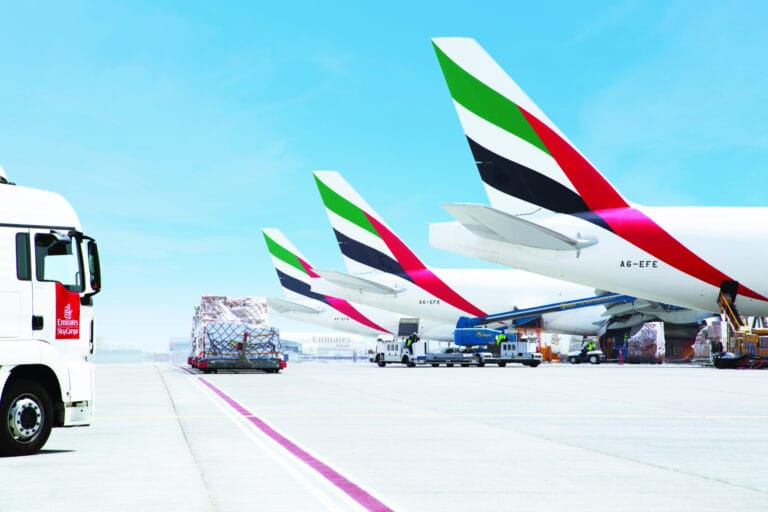- Dubai’s logistics rise is deeply intertwined with Emirates SkyCargo’s global expansion, connecting two-thirds of the world’s population within eight hours and aligning with the city’s D33 Economic Agenda to link 400 destinations — a reflection of the emirate’s relentless drive to perfect seamless global trade.
- Infrastructure innovation defines the next chapter, with Emirates preparing to relocate to what could become the world’s largest airport, exploring underground facilities and first-line technology to optimise cargo flow while maintaining its leading position in global freight connectivity.
- Adaptability remains Emirates’ greatest strength, as it expands its fleet amid aircraft delivery delays, hedges with ACMI leases and conversions, and continues to anticipate shifts like the surge in e-commerce — all backed by Dubai’s uniquely collaborative ecosystem of regulators, trade zones, and government foresight.
Dubai has long captivated the imagination of the logistics world, serving as a strategic hub where commerce, policy, and aviation intersect.
“Emirates, of course, was founded in 1985 and since then, the move has been incredible,” Jeffrey Van Haeften is the Senior Vice President of Cargo Commercial Worldwide at Emirates SkyCargo, explained. “If you look how big our network right now is, and within eight hours, you connect more or less two-thirds of the world population, then of course, you can say that Dubai has grown with Emirates, and Emirates has grown with Dubai.”
That growth is not accidental — it’s strategic, relentless, and deeply aligned with the city’s economic aspirations. Van Haeften pointed to initiatives such as Dubai’s D33 Economic Agenda, which aims to connect the city with 400 global destinations within a decade. “It’s interesting what they’re doing. They want, of course, to double the investment climate in Dubai that attracts business. And if you want to do seamless business in logistics, you need to make sure everything is perfect.”
Building tomorrow
With Dubai Airports preparing for the next phase of expansion — including what may become the world’s largest airport — Emirates SkyCargo is poised to capitalise on the Middle East’s potential.
“In a few years, we will move all together to a new airport — incredibly large. If you compare it with other airports in the world, the distances are amazing,” Van Haeften noted.
“It can take you up to an hour to go from one to the other side… as cargo, you don’t want distances that take an hour.”
That challenge, in part driven by Dubai’s climate and scale, is spurring innovation. “We look at first-line technology. We’re looking at facilities which go underground. So a lot of things will be tunnelled.”
Despite the ambition, Van Haeften emphasised that standards will not be compromised. “Our competition is not sitting idle either. So you have to make sure that if you build something new, you will remain the first-line priority for developing your hub.”
One of Emirates’ competitive advantages is its use of belly cargo across its vast passenger network — an expansive distribution capability that few freight-only carriers can rival. “We connect, for example, 42 cities in Europe — most of them are double daily, triple daily. London Heathrow, even six times a day,” Van Haeften shared. “So we have our freighter equipment coming to Dubai, and then connect mainly on, predominantly, our bellies.”
Shaping demand
One of the defining factors of Emirates SkyCargo operations is its ability to forecast and respond to market shifts — particularly in segments like e-commerce, which are reshaping global air freight demand.
“Every year a new younger generation starts to get access to a credit card and a phone and can order goods,” Van Haeften observed. “They’re not traditional buyers anymore. So you automatically will see an increase in demand.”
This growing demand places greater pressure on operational infrastructure, partner responsiveness, and governmental support. But for Emirates, that synergy is already in place. “If you look at the Dubai government, they fully understand what we require,” he said. “If you look at the DW airport, it’s close to the biggest trade zone — Jebel Ali — connecting sea freight. And Dubai is more or less the last stop you can have with your ocean vessel without going through the Suez.”
The regulatory ecosystem is another crucial enabler. “Authorities, police, customs — all the regulators — are working together to make the journey seamless,” he emphasises. “So if we have something coming from the professor, it can take up to three days before you can connect with a carrier. With us, it’s happening in a few hours, which is unheard of.”
Van Haeften credited the region’s “progressive and future thinking” culture, noting that Dubai operates with a mindset closer to a corporation than a city. “In Europe, you will never see this… overnight they redo the whole road network. They are really progressive.”
Navigating global constraints
While infrastructure and partnerships have been crucial, Emirates SkyCargo’s continued expansion depends equally on its fleet — a particularly tricky issue in a time of aircraft delivery delays and manufacturing bottlenecks.
“We are still behind with the 777X,” Van Haeften conceded. “Approval is not there.” But that hasn’t stalled progress.
“We were quite bold. Even two years ago, when the market was not super, we made some orders, but we also did extra ACMI [wet lease], because we saw the boost in e-commerce really coming up.”
Emirates SkyCargo currently operates 10 freighters and six ACMI aircraft, with plans to expand to 21 owned aircraft by the end of 2026. “We’re not betting on one horse,” he explains. “We have a spread-around program… and we still have an opportunity with the 777 passenger fleet to convert them.”
Conversions are on the table, but cautious. “We have, officially, ten 300s which can be converted… but it’s always a decision we make later on. We have the potential.”
In an industry where delays are common and capital investments are long-term bets, Emirates’ multifaceted strategy — balancing ACMI, orders, and potential conversions — offers a robust hedge. “We now going, really, against the rest of the world. We’re doubling our fleet,” he stated proudly.
Adaptability as DNA
The cargo world is no stranger to volatility — from geopolitical tensions to supply chain breakdowns. For Van Haeften, the key isn’t in avoiding disruption, but in responding with agility and foresight.
“If you look at the last 10 years, we had more challenges… Covid-19 was maybe one of the biggest,” he reflected. “But demand for air freight is almost like a river… it will find its way.”
That adaptability extends across all levels of the organisation. “It’s not only the fleet. It’s also the people. You need to adapt as an organisation quickly. We have a very small team which can take a decision like that, and then you can almost change your routines overnight.”
Even in the face of geopolitical uncertainty, Emirates’ diversified operations offer a natural buffer. “We’re not super exposed to the US,” he continued. “We are quite well spread… so I can say we’re quite flexible and adaptable.”
Looking forward, Van Haeften remains optimistic: “Honestly, we had a very good year, last financial year. I still see, till today, that the demand from all continents is quite healthy.”





